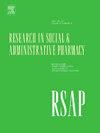实施科学和企业家精神:推进药学实践的两个互补框架
IF 3.7
3区 医学
Q1 PUBLIC, ENVIRONMENTAL & OCCUPATIONAL HEALTH
Research in Social & Administrative Pharmacy
Pub Date : 2025-04-02
DOI:10.1016/j.sapharm.2025.03.065
引用次数: 0
摘要
学术领袖和临床医生已经将实施科学(IS)和企业家精神(EN)作为转变药学教育和实践的框架。虽然不同,但IS和EN在促进解决医疗保健问题方面有许多相同的流程和目标。目的区分IS与EN的异同。每种方法的主要组成部分将评估其相对优势和局限性,以促进药房实践干预。方法比较IS和EN的基本成分。本文采用实施研究干预综合框架(CFIR)来表示创业信息系统的要素,采用资源基础竞争优势理论来实现创业中的关键结构。这5个CFIR领域与资源基础竞争优势理论的5个构建相匹配,允许5个共同组成部分进行比较:(1)干预、(2)成本效益、(3)市场生存能力、(4)组织设置和(5)个人和投入特征。结果si和EN是两种学术方法,主要区别在于它们如何构建研究问题。信息系统框架优先研究基于证据的干预措施的实施及其理论贡献。它们主要侧重于量化干预的影响,而较少关注社区伙伴的需求、干预的市场可行性和投资回报。EN对缺乏强有力的客观证据证明有效性的干预措施持更开放的态度,更多地依赖于使干预在财务上可持续和在市场上有利可图的因素。结论is和EN都考察了干预措施、组织、市场可行性、投入和财务回报对干预措施的成功采用和可持续性的作用。任何一个框架都可以用来促进药学实践干预措施的采用和传播,只要研究人员了解每个框架的局限性。本文章由计算机程序翻译,如有差异,请以英文原文为准。
Implementation science and entrepreneurship: Two complementary frameworks for advancing pharmacy practice
Background
Academic leaders and clinicians have promoted implementation science (IS) and entrepreneurship (EN) as frameworks for transforming pharmacy education and practice. Although distinct, IS and EN share many of the same processes and goals in promoting solutions to problems in healthcare.
Objectives
To distinguish the similarities and differences between IS and EN. Major components of each method will be evaluated for relative strengths and limitations in advancing pharmacy practice interventions.
Methods
Basic components of IS and EN were compared. The Consolidated Framework for Implementation Research Intervention (CFIR) was used to represent the elements of IS and the resource-based theory of competitive advantage was used to operationalize key constructs in entrepreneurship. The five CFIR domains matched well with the five constructs of the resource-based theory of competitive advantage, allowing five common components for comparisons: (1) intervention, (2) cost benefit, (3) market viability, (4) organizational setting, and (5) characteristics of the individuals and inputs.
Results
IS and EN are two scholarly approaches that differ primarily in how they frame research questions. IS frameworks prioritize the study of the implementation of evidence-based interventions and their theoretical contributions. They focus predominantly on quantifying the impact of the intervention and less so on the needs of community partners, market viability of intervention, and return on investment. EN is more open to interventions that lack strong objective evidence for effectiveness, relying more on what makes an intervention financially sustainable and profitable in markets.
Conclusion
IS and EN both examine the role of the intervention, organization, market viability, inputs, and financial return on the successful adoption and sustainability of interventions. Either framework can be used to advance the adoption and dissemination of pharmacy practice interventions, as long as researchers understand the limitations of each framework.
求助全文
通过发布文献求助,成功后即可免费获取论文全文。
去求助
来源期刊

Research in Social & Administrative Pharmacy
PUBLIC, ENVIRONMENTAL & OCCUPATIONAL HEALTH-
CiteScore
7.20
自引率
10.30%
发文量
225
审稿时长
47 days
期刊介绍:
Research in Social and Administrative Pharmacy (RSAP) is a quarterly publication featuring original scientific reports and comprehensive review articles in the social and administrative pharmaceutical sciences. Topics of interest include outcomes evaluation of products, programs, or services; pharmacoepidemiology; medication adherence; direct-to-consumer advertising of prescription medications; disease state management; health systems reform; drug marketing; medication distribution systems such as e-prescribing; web-based pharmaceutical/medical services; drug commerce and re-importation; and health professions workforce issues.
 求助内容:
求助内容: 应助结果提醒方式:
应助结果提醒方式:


